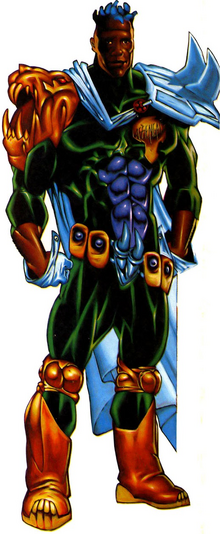
Judge Kwame Assengai, in 2116
The Pan-African Judges police the areas of the continent that fall under the Pan-African Compromise: simply, the less powerful cities and countries of the continent. The judiciary was based out of Siwa, with mission control stations in Bangui (Central African Republic), Chad, and Tibesti mountains. A wider variety of people were in the Judges than in more unified megacities, with Judges showing political ideologies (such as communism) and more open religious beliefs.
Crimes they dealt with included slave-trading and poaching. the latter carried a death sentence as Pan-Africa's shattered biosphere was reliant on 'farming' cloned prehistoric animals long-term and because one day, Pan-Africa might be able to benefit from ivory sales itself; poachers were seen as "steal[ing] the seeds", in the words of Judge Adam Smith. [1]
Many places even there refuse to acknowledge their jurisdiction and they are legally barred from entering places outside the Compromise. In the communist People's Republic of Freedonia, a Pan-African Judge could be executed as a spy. The Pan-African Judges considered that this would be different, once the continent was unified.[2]
History[]
The force was formed after the Credit Wars, as part of the sop to get non-African megacities to stand down. They (or at least Judge Kwame Assengai and his patrol) believed one day, Africa would exist as a unified force and the law would be different.
Judge Assengai once tracked the poacher James Van Buesen to Cairo and believed he'd killed him. However, a Freedonian doctor helping the poor patched up his head wounds with Van Buesen's ivory (the poacher demanded to have tusks grafted on for aesthetics). Van Buesen bribed his way into Freedonia, giving them money for the healthcare system in exchange for hiding him.[3]
Rashid el Sadiq was, in his words, "an evil man" until he converted to Islam. To redeem himself, he joined the Judges.[4]
In 2114, the Pan-African Judge hierarchy attended the Hondo conference about Judgement Day.

Judge Sadiq deals with a perp.
In 2116, Justice Patrol 8 - Judges Assengai, el Sadiq, communist Adam Smith, afrikaner Kit Rothman, and Brit-Cit transfer Becky Steel - learned Van Buesen was still alive and butchering mastodons in the Guinea Development Area. They tracked him to Freedonia where, rather than risk killing locals, Assengai surrendered. The government ordered them "deported" by "Peoples' Deputy" Van Buesen, who tortured the patrol before hanging them up from a tree to slowly die. After hours spent up, they were resigned to death before a lucky thunderstorm split the tree, attracting a travelling merchant who saved them. Judge Steel was left with severe facial scaring and, after talking with el Sadiq, converted to Islam. After recovering, Patrol 8 tracked down Van Buesen and wiped out most of his gang; the villain himself escaped only to be killed by rivals poachers and his ivory carved off. [5]

Rarely seen stylised lion helmet, here worn by Judge Rothman
When the global InterDep agency began pushing for more concessions and active involvement in the megacities, the Pan-African judiciary were in favour. Unknown to the Judges, the corrupted InterDep had triggered a violent war between factions in the Afrikaner Townships around the Kenyetta Sea. [6]
In 2117, the Pan-African Judges were one of the multiple judicial forces that tried to get access to Tek-Judge Eckhart in Antarctica. Judge Daktari was killed in battle with Hondo City's Judge Shojo. [7]

Judges wiped out by Shango, 2117
Later that year, high command ordered Sadiq to sell Steel into slavery so they could track Sade and her zombie ship; Steel could not be informed, as the sale needed to seem legit to trick the slavers. This mission was undercut when the Yoruba gods returned to Africa; they arranged for Judge Assengai to be struck down as a sacrifice and for Shango to take his body. When the Judges arrested the god Esu in the city of Ife, believing him a troublemaking drunk, he devastated the city and led his pantheon in a rampage across Sub-Saharan Africa (abducting twenty million children to worship them) before heading east to Egypt, abandoning the areas to their witches. The Pan-African Judge forces had united with Simba City's army in a counterstrike but were devastated by the might of Shango. Within a few days, swathes of the continent were devastated and the Pan-African Judges were in disarray: many Judges were dead and Mission Control Bangui, Station Chad, and Station Tibesti were wiped out. As Esu had used magic to cut communications, the outside world was unaware of the destruction.
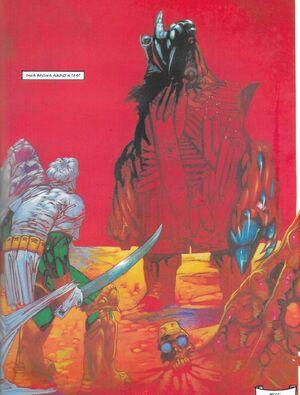
Judge Sadiq faces a god
As Steel and Sadiq had missed the events due to the mission, they were the only Judges in a position to retaliate. While Steel was left in an alliance with Sade, Sadiq teamed up with a group of holy men (all of whom died). They and Sade competed with the gods in a series of trials on the astral plain and failed each one, but their cries for help was able to awaken Assengai's consciousness. Out of fear of a mortal wielding Shango's powers, the gods retreated. A resurrected Assengai, Sadiq, and Steel were picked up days later and taken to Siwa to explain the crisis.[8]
In 2122, the Pan-African Judges had jurisdiction over the newly established megacity Timbuk2. However, when the Herod attacked, Vatican agents found the Pan-African Judges "don't want to knos". The Vatican agents also felt there was no "half competent" Psi group in the area. [9]
Equipment[]
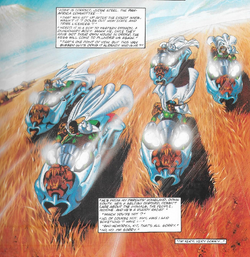
Pan-African Lawmasters
In the 2110s, the Judges rode armoured hoverbikes with a lion-head frontpiece - as with Mega-City One, they were called Lawmasters.[10] Firearms were oversized sidearms with devastatingly powerful bullets.
In extreme cases, the Judges had battle-tanks.
Depiction[]
The concept of a Pan-African Judge first turned up in a poster for the 1988 Judge Dredd Mega-Special drawn by Brendan McCarthy: the text said they had the hardest job of any Judge, "policing a society that mixes centuries' old tribal law and customs with high 22nd century technology. Applicants chosen for linguistic and diplomatic skills."
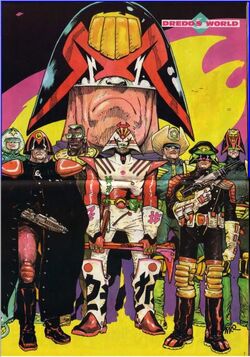
The Dredd's World poster, McCarthy's Judge design between Sov and Hondo.
After a single cameo in Judgement Day, the Judges' look was replaced by a Siku design in 1993 - a text feature in Megazine (Vol.2) #55 claimed those Judges had been Simba City Judges instead (which would later be contradicted in strip). [11] In an article in Judge Dredd Megazine #238, Siku said he got the job after criticising the McCarthy design as too stereotyped: "I asked, why do people think all Africans run around in animal prints? [Editor] Dave Bishop challenged me to come up with something better."
In the same article, Siku referred to Paul Cornell's first Pan African script as being well researched but flawed in its approach - "imperialism, jungle safaris, that's the way Westerners see Africa". (The second Pan African strip was written by Siku alone and had Yoruba gods attacking the continent.) He did enjoy having a "token white guy" Judge. Cornell himself referred to his work as "a trudge", feeling it had too many competing ideas in one story and that his dialogue was "overblown"; he was happy, however, with his decision to deliberately show Islam and a Muslim Judge, as he felt the Judge Dredd universe was "a little too disconnected from the real world" by turning all the world's religions into the worship of Grud.
References[]
- ↑ Pan-African Judges Part 1
- ↑ Pan-African Judges Part 1
- ↑ Pan_African Judges Part 2
- ↑ Pan-African Judges Part 2
- ↑ Pan-African Judges first series, Megs 2.44 to 2.49
- ↑ Wetworks
- ↑ "Crusade": progs 928 to 937
- ↑ Megazine 3.06 to 3.13: "Fever of the Gods"
- ↑ Devlin Waugh: Reign of Frogs
- ↑ Megazine 3.06
- ↑ Inquisition feature, Megazine 2.55
